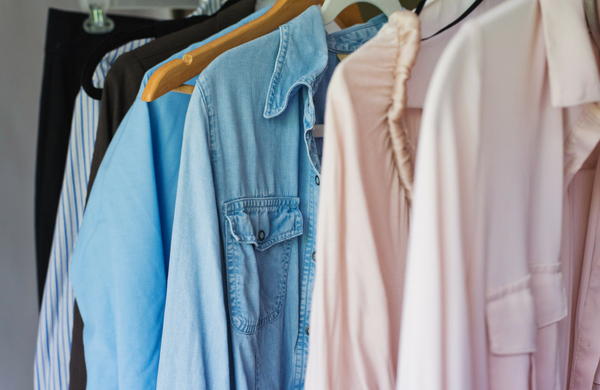When Should You Dry Clean Clothes? A Quick Guide to Clothing Care
We teach you the ins and outs of fabric care instructions.

It's a scenario familiar to all of us. You fall in love with a piece of clothing, only to see a 'Dry Clean Only' tag on the label. You may ask yourself, Is this skirt or dress worth the investment? Can I actually wash this at home? Why do some pieces of clothing need to be dry cleaned?
CheapThriftyLiving is here to answer your questions about the dry cleaning process, from how dry cleaning works to why and when you should dry clean clothes. Our quick guide to clothing care discusses why some fabrics require special treatment and how you can get the most of out of your 'Dry Clean Only' clothing.
If you're new to handling specialty fabrics or are just wondering how to get the most wear out of your favorite suede jacket, then don't miss our collection of specialty fabric tips located at the bottom of this page. Learn the ins and outs of dry cleaning as we answer the age-old question, 'When Should You Dry Clean Clothes?'
What is Dry Cleaning?
If you've never had clothing dry cleaned before, or you're debating whether to have a garment dry cleaned, you may be asking: What is dry cleaning? Dry cleaning is named so because it's a cleaning process that doesn't involve water, unlike traditional hand and machine washing. Instead, dry cleaning uses a liquid solvent to clean garments, perchlorethylene.
When you drop a garment off at your local dry cleaners, your clothing is tagged, which identifies the owners of the garment, and notes any missing buttons or other stains that need special attention. For example, if your dress has a red wine stain, the dry cleaning operators will make a note of this so that the stain can be pre-treated before the actual dry cleaning process begins.
The way the actual process of dry cleaning works is quite fascinating. Up to 100 pounds of clothing is placed into a cleaning machine, which rotates the clothing and simultaneously sprays them with the solvent. Dirty solvent is pumped through a filter and then re-circulated.
The solvent is then drained and then clothing is dried with warm air, which dissolves any remaining solvent. Clothing is then given another spot treatment process for any remaining stains. Dry cleaning easily removes grease and oil stains, but some stains, such as bleach spotting or already faded dye may not be able to be removed.

Why Are Some Clothes Dry Clean Only?
We've all looked at a garment label and wondered, 'Why does this need to be dry cleaned?' The majority of dry clean only clothing are made with specialty fabrics that are often too delicate for machine washing, or that require special care, like suede. However, there are several other reasons for clothing items to require dry cleaning.
*Suits or heavily structured clothing - Clothing that is heavily structured benefits from the dry cleaning process, as it is less likely than machine washing to damage the clothing's structure.
*Clothing that features beading or heavy embellishment - Heavily embellished clothing, especially if it's made from delicate fabric, should be dry cleaned or, in some cases, hand washed. Machine washing embellished clothing can result in torn, ripped, or missing beads or thread.
*Some household items - Mattress protectors, cushions, and some quilts should be dry cleaned. Antique quilts however, should be hand washed. You can read more about how to treat antique quilts in this article, How to Store and Preserve Your Quilt.
Did You Know? The FTC (Federal Trade Commission) regulates clothing labels, including those marked 'Dry Clean' and 'Dry Clean Only'. Clothing can only be marked 'Dry Clean Only' if there is proof that washing will harm the garment.
When Should You Dry Clean Clothes?
So we've come to the basic question, when do I have to dry clean clothes, and the more important question, does this really have to be dry cleaned? The answer to the first question is fairly straight-forward.
Generally, most dry clean only items can be worn 4-5 times before they need to be professionally dry cleaned. This includes business suits, button-downs shirts (excluding white shirts), and casual dresses. A great way to prolong the period between each dry cleaning is to hang up your clothes when you finish wearing them instead of folding them; this will help prevent wrinkles and will help the garments keep their structure between cleanings. However, if an item is stained and has collected moisture aka absorbed sweat, they'll need to be cleaned more frequently. Special occasion items, like wedding or prom dresses or dress suits, should be dry cleaned after each use.
The second question, does a clothing item really have to be dry cleaned, is a little trickier to answer. The real answer is...sometimes. Whether a dry clean only item can be washed at home depends on a lot of factors, but the most important factor to consider is fabric. Some clothing made from natural fibers (cotton or linen) can be washed at home, although it's recommended to spot test washing the fabric before washing the entire garment. If you're going to attempt to home wash something labeled 'Dry Clean Only', be sure to hand wash the clothing, or machine wash with cold water, using a gentle or delicate cycle.
If your clothing is made from specialty fabrics, then you'll probably want to have them dry cleaned. Silk and wool are tricky fabrics to machine wash, as are delicate synthethic fabrics like rayon. Clothing that's heavily embellished or structured should be dry cleaned to prevent any damage.

Tips for Specialty Fabric Care
Between dry cleanings, there are special steps you can take to make sure your clothing remains in good shape. Below, we've covered six types of specialty fabrics and have included a few quick tips for making sure your clothing is well cared for.
Suede: Suede is a type of leather that has a special napped finish and is typically made for outerwear, such as shoes and jackets, and some types of home decor. Suede is a fabric that stains very easily, so it's important to take good care of any suede items you may own. Stain removers should not be used to treat suede; instead, a slightly damp towel should be used on stained suede. Because the color of suede can quickly fade, it's important to store any suede clothing in a dark and dry place. It is not recommended to store suede clothing in plastic, as plastic can dry and crack the leather.
Satin: Satin is a delicate fabric with a shiny, smooth appearance, and is typically used in special occasion clothing. If you're washing satin at home, be sure to hand wash your satin clothing in cold water. Do not twist water out of the fabric, as this will cause the satin to lose its shape. Satin should be dried laying flat, and delicate satin clothing should be dry cleaned.
Velvet: Velvet is a fabric that is often a combination of silk, cotton, or nylon, and has a pile, which gives it its soft touch. Velvet is a very difficult fabric to treat at home, but if you do need to clean velvet, it is recommended that you use a steamer to remove wrinkles. Do not ever iron velvet; ironing velvet can scorch the fabric and crush the pile. If possible, try to avoid folding velvet and hang velvet clothing to avoid crushing the fabric's pile.
Wool: Wool, made from animal fibers, is a heavy and warm fabric that can require special care, depending on the type of wool present in a garment. If washing wool at home, be sure to lay the wool garment flat; hanging a wet wool garment can cause the heavy fabric to lose its shape. Wool garments should be hand washed if possible, although some wool can be machine washed using a delicate cycle.
Silk: Silk fabric has been around for centuries and is well know for its luxurious, smooth feel. If a piece of silk clothing has a stain, do not spot treat the silk; this can further damage the fabric. Instead, let the clothing soak after being washed. Bleach should not be used on silk, and cold water should be used when washing. Similar to satin, it's important to not twist the fabric to remove excess water, as it can cause the fabric to lose its shape. Silk should not be placed in a tumble dryer.
Taffeta: Taffeta is a specialty fabric often used in wedding gowns and prom dresses. Taffeta can be made with real silk or synthetic fibers, and requires special care. Some taffeta can be machine washed using a delicate cycle, although hand washing is recommended. Like silk, taffeta should not be spot treated for stains, and should not be hung in direct sunlight, as this can cause discoloration in the fabric.

Easy Tips for Making Your Clothes Last Longer
If you're looking to prolong periods between visits to the dry cleaners or are just searching for ways to make your favorite pair of jeans last longer, then check out these quick clothing care tips. These tips will help your clothes last longer, and will help preserve their color, shape, and texture. Stop shrinking your jeans and keep your favorite dress looking fabulous by following our handy clothing care guide that's good for your wardrobe and your wallet.
Machine wash clothes in cold water. Trust us, washing clothes in cold water will make your clothing last longer. Hot water, while fine for towels and washcloths, can wreak havoc on clothing, as hot water can shrink fabric and permanently set stains. Hot water also has the disadvantage of making clothing dye bleed or fade faster, so any clothing that's new or dark should be washed in cold water. This same philosophy also applies to hot tumble dryers. If you want to get more mileage out of clothing, letting your clothes air dry, either while hanging or laying flat, will help them keep their shape. If you're worried about wrinkles, you can always iron or steam clothing.
Read the fabric care label. No, you can't just throw a dressy silk top in your washing machine with a pair of your hubby's dirty work jeans. Not all fabric was made equal, so reading how to care for your clothes according to the label is important. We recommend doing this in the store before you purchase your item instead of waiting until the first time you wash it; that way you can decide if more expensive and delicate clothing that requires special care is worth the price.
Inspect and treat stains properly. While some stains can be spot treated with stain removal pens, others require very special care. You cannot treat a shoe polish stain the same way you treat a blood stain, so be sure to read up on the correct way to remove stains (The Spruce has a great guide for this here). Take it from someone who spilled perfume oil on her favorite dress and ruined it in the process of cleaning it: once a stain sets, it is very difficult to remove.
Button, zip, and tie your clothes before washing them. Not only will doing this help your clothes keep their shape, but your clothes will be less likely to snag or accidentally tear your other clothing in the wash.
Don't overload your washing machine. We know it seems easy to throw in a giant load of clothing as opposed to doing two medium sized loads of laundry, but overloading your washing machine does two things. One, it gives your clothes a less thorough clean, and two, it can make your clothing rub together and wear thin or pill. Keep your clothing in better shape by washing them in smaller loads and hand washing delicate items when possible.
What clothing care tips do you have? Let us know below in the comments!
Up Next 30 DIY Old Clothes Ideas











